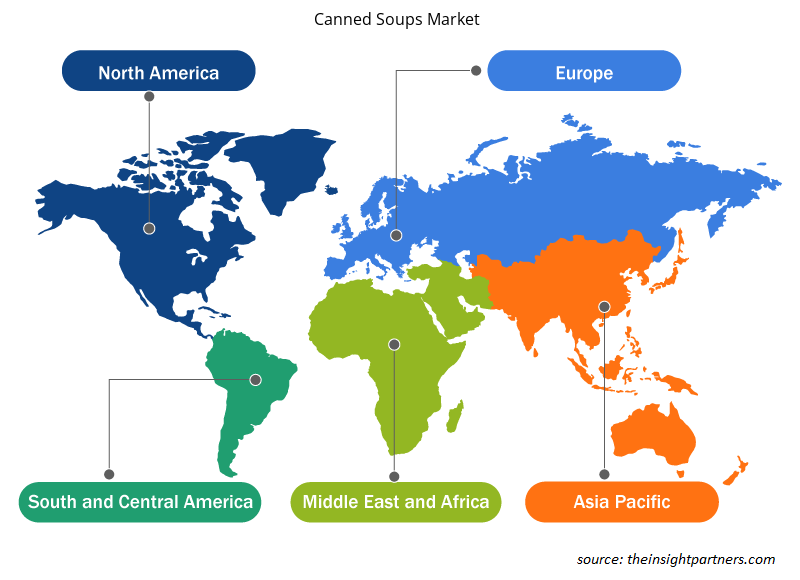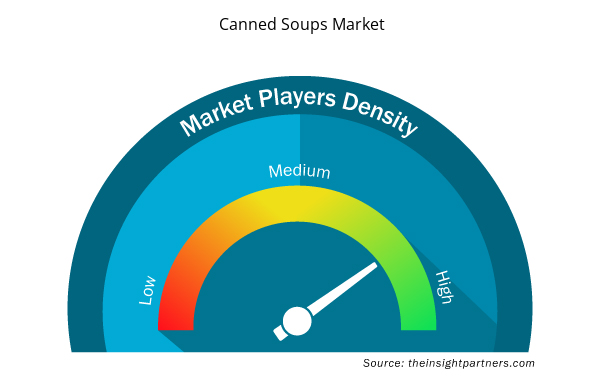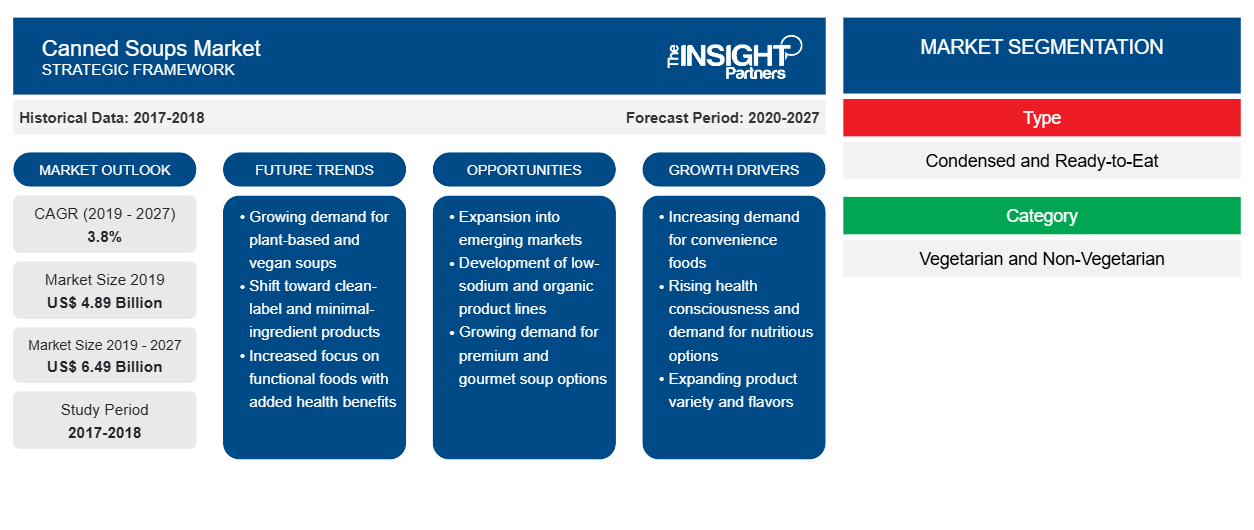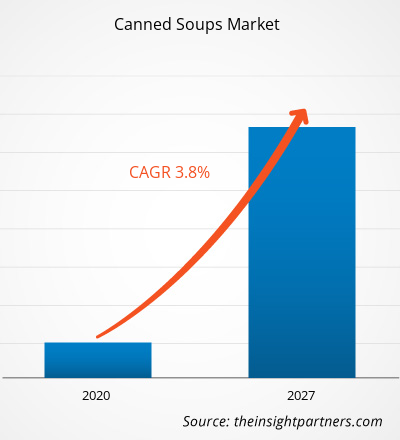2019 年罐头汤市场价值为 48.8904 亿美元,预计 2020 年至 2027 年的复合年增长率为 3.8%。
对即食食品的需求旺盛、消费者食品偏好的快速转变以及对健康的日益关注推动了罐头汤市场的增长。罐头汤是一种即食方便食品,在市场上很容易买到。罐头汤的加工很容易,准备时间也更短。由于消费者对这些产品的接受度高,以及发展中经济体的品牌知名度高,罐头汤的出口业务近年来也有所增长。此外,劳动人口的增长和对加工食品因其健康益处而越来越偏好,也刺激了对罐头汤产品的需求。此外,亚太地区发展中国家(如中国和印度)农村人口向城市地区的转移预计也将增加对各种消费品的需求,这也有望 在预测期内推动罐头汤市场的增长。
2019 年,北美在全球罐头汤市场中占据最大份额。北美肥胖率的上升和健康意识运动的兴起推动了对含有天然和新鲜成分的包装汤的需求。因此,对罐头汤的需求也有所增加,制造商正在为消费者提供不同的口味。产品种类的增加、健康产品消费的激增以及该地区主要参与者的推广,增加了北美对罐头汤的需求。
2019 年 12 月,武汉首次报告了 COVID-19 疫情。截至 2021 年 1 月,美国、巴西、印度、俄罗斯、西班牙和英国是确诊病例和死亡人数最多的国家。由于封锁、旅行禁令和企业停业,疫情对各国的经济和行业产生了不利影响。食品和饮料是世界主要行业之一,遭受了供应链中断、技术活动取消和办公室关闭等严重破坏。例如,中国是全球制造业中心和各行业最大的原材料供应国,也是受影响最严重的国家之一。中国各工厂的封锁扰乱了全球供应链,阻碍了制造活动、交付计划和各种材料销售。多家公司已经宣布产品交付可能延迟,未来产品销售下滑。此外,欧洲、亚洲和北美国家实施的全球旅行禁令阻碍了商业合作和伙伴关系机会。所有这些因素都在阻碍行业发展,从而成为该行业相关各个市场增长的制约因素。
定制此报告以满足您的需求
您可以免费定制任何报告,包括本报告的部分内容、国家级分析、Excel 数据包,以及为初创企业和大学提供优惠和折扣
- 获取此报告的关键市场趋势。这个免费样品将包括数据分析,从市场趋势到估计和预测。
市场洞察
罐头食品保质期长
任何罐头汤的保质期都是其变质至不可食用状态所需的时间。罐头汤产品中添加的延长保质期成分可减缓食品变质过程,延长食品的储存时间。它们既有有机成分,也有传统成分。延长保质期的成分还有助于保持食品物流畅通,在冷冻地区维持罐头汤的品质,并提高消费者对食品稳定性的信心。消费者对饮食的认识有所提高。提高免疫力、降低热量摄入和高蛋白质摄入等健康益处是预计会影响产品需求的其他因素。此外,保质期长的罐头汤还含有丰富的营养、矿物质、维生素和蛋白质。在全球范围内,年轻人更喜欢购买优质商品,因为它们具有健康属性,并准备改变他们的习惯,追求更健康的营养。用新鲜蔬菜、骨头和肉类制成的罐头汤广受欢迎,因为它具有多种健康益处和营养,而且保质期长。此外,消费者选择罐装汤产品而不是其他蛋白质来源,因为它具有诸多好处,例如大量营养素和微量营养素的比例合理,蛋白质含量高。此外,由于包装方便,包装汤比餐馆和食品店供应的汤更受欢迎。喝罐装汤或做简单的汤有助于在饮食中添加更多蛋白质,并防止摄入过多卡路里。因此,消费者对营养罐头汤的倾向推动了市场的增长。
类型洞察
根据类型,全球罐装汤市场分为浓缩汤和即食汤。2091 年,浓缩汤占据市场主导地位。浓缩罐装汤产品采用各种调味料和营养价值高的食物制成。饮用浓缩汤有许多健康益处,它还是蛋白质和钙的浓缩来源,对身体的构建起着至关重要的作用。因此,浓缩汤市场预计将在预测期内大幅增长。
分销渠道洞察
根据分销渠道,罐头汤市场分为大卖场/超市、便利店、线上和其他。2019 年,大卖场/超市占据了市场主导地位,而线上市场预计将在 2020-2027 年以最快的速度增长。大卖场和超市被认为是罐头汤和其他各种产品的次要销售渠道。罐头汤也以醒目的组合摆放在大卖场和超市的货架上,以吸引顾客。这些商店在一个地方提供不同品牌的产品,价格比其他分销渠道更实惠。此外,不同品牌的产品摆放在附近,以帮助买家在更短的时间内选择合适的产品。除此之外,无忧交易、批量购买、更好的服务和愉快的客户体验等因素也鼓励买家从大卖场和超市购物。
罐头汤市场的一些主要参与者是金宝汤公司、Amy's Kitchen Inc、General Mills Inc.、卡夫亨氏公司、百特食品集团、联合利华、Struik Foods Europe NV、Vanee Foods Company、BCI Foods Inc. 和 Hain Celestial Companies。这些公司为罐头汤市场提供广泛的产品组合。它们还在发展中地区占有一席之地,这为罐头汤市场的增长提供了有利可图的机会。
罐头汤市场区域洞察
Insight Partners 的分析师已详细解释了预测期内影响罐头汤市场的区域趋势和因素。本节还讨论了北美、欧洲、亚太地区、中东和非洲以及南美和中美洲的罐头汤市场细分和地理位置。

- 获取罐头汤市场的区域特定数据
罐头汤市场报告范围
| 报告属性 | 细节 |
|---|---|
| 2019 年市场规模 | 48.9亿美元 |
| 2027 年市场规模 | 64.9 亿美元 |
| 全球复合年增长率(2019 - 2027) | 3.8% |
| 史料 | 2017-2018 |
| 预测期 | 2020-2027 |
| 涵盖的领域 | 按类型
|
| 覆盖地区和国家 | 北美
|
| 市场领导者和主要公司简介 |
|
罐头汤市场参与者密度:了解其对业务动态的影响
罐头汤市场正在快速增长,这得益于终端用户需求的不断增长,这些需求源于消费者偏好的不断变化、技术进步以及对产品优势的认识不断提高等因素。随着需求的增加,企业正在扩大其产品范围,进行创新以满足消费者的需求,并利用新兴趋势,从而进一步推动市场增长。
市场参与者密度是指在特定市场或行业内运营的企业或公司的分布情况。它表明在给定市场空间中,相对于其规模或总市场价值,有多少竞争对手(市场参与者)存在。
在罐头汤市场运营的主要公司有:
- 金宝汤公司
- 艾米
免责声明:上面列出的公司没有按照任何特定顺序排列。

- 获取罐头汤市场顶级关键参与者概述
报告亮点
- 全球罐头汤市场的渐进式行业趋势可帮助参与者制定有效的长期战略
- 发达市场和发展中市场采用的业务增长战略
- 2017 年至 2027 年市场定量分析
- 各行业对罐头汤的需求估计
- PEST 分析可说明行业内买家和供应商预测市场增长的有效性
- 了解竞争激烈的市场形势和罐头汤的需求的最新发展
- 市场趋势和前景,以及推动和抑制罐头汤市场增长的因素
- 通过了解支撑全球罐头汤市场增长的商业利益的策略来进行决策过程
- 不同市场节点的罐头汤市场规模
- 全球罐头汤市场的详细概述和细分以及其行业动态
- 各地区罐头汤市场规模及增长机遇
罐头汤市场(按类型)
- 浓缩版
- 即食
罐头汤市场(按类别)
- 素食
- 非素食
罐头汤市场,按加工方式分类
- 普通汤
- 有机汤
罐头汤市场,按分销渠道划分
- 大卖场/超市
- 便利店
- 在线的
- 其他的
公司简介
- 金宝汤公司
- 艾米厨房公司
- 通用磨坊公司
- 卡夫亨氏公司
- 百特食品集团
- 联合利华
- 斯特鲁克食品欧洲公司
- Vanee 食品公司
- BCI 食品公司
- 海恩·塞莱斯蒂尔
- 历史分析(2 年)、基准年、预测(7 年)及复合年增长率
- PEST 和 SWOT 分析
- 市场规模价值/数量 - 全球、区域、国家
- 行业和竞争格局
- Excel 数据集



Report Coverage
Revenue forecast, Company Analysis, Industry landscape, Growth factors, and Trends

Segment Covered
This text is related
to segments covered.

Regional Scope
North America, Europe, Asia Pacific, Middle East & Africa, South & Central America

Country Scope
This text is related
to country scope.
常见问题
The condensed segment had a significant market share, and this trend is expected to continue over the forecast period. Condensed soup is a type of canned soup prepared with a low proportion of water, in which consumers can add milk or water during consumption. The global market for canned soups is projected to expand at a robust rate as canned soups products become popular worldwide. Canned soups made from fresh vegetables have gained tremendous popularity due to this soup's health benefits and nutritional value. Furthermore, the development of new preparation styles for canned soups has also aided the growth of the global canned soups market.
The major players operating in the global canned soups market are Amy’s Kitchen Inc, Baxters Food Group, Campbell soup Company, The Kraft Heinz Company, General Mills Inc., Unilever, Hain Celestial, Struik Foods Europe NV, Vanee Foods Company, and BCI Foods Inc., among others.
In 2019, North America contributed to the largest share in the global canned soups market. There has been an increasing instance of obesity as well as health awareness campaigns in the North American countries which has increased the demand for packaged soup having natural and fresh ingredients. Due to the growing demand for packaged soup, the demand for canned soup has also increased, and manufacturers are providing different flavors to the consumers. The increase in the variety of products, increase in the consumption of health-related products, and promotion by the key players in the region has increased the demand for canned soup in North America.
Trends and growth analysis reports related to Food and Beverages : READ MORE..
The List of Companies - Canned Soups Market
- Campbell Soup Company
- Amy’s Kitchen Inc
- General Mills Inc.
- The Kraft Heinz Company
- Baxters Food Group
- Unilever
- Struik Foods Europe NV
- Vanee Foods Company
- BCI Foods Inc.
- Hain Celestial
The Insight Partners performs research in 4 major stages: Data Collection & Secondary Research, Primary Research, Data Analysis and Data Triangulation & Final Review.
- Data Collection and Secondary Research:
As a market research and consulting firm operating from a decade, we have published and advised several client across the globe. First step for any study will start with an assessment of currently available data and insights from existing reports. Further, historical and current market information is collected from Investor Presentations, Annual Reports, SEC Filings, etc., and other information related to company’s performance and market positioning are gathered from Paid Databases (Factiva, Hoovers, and Reuters) and various other publications available in public domain.
Several associations trade associates, technical forums, institutes, societies and organization are accessed to gain technical as well as market related insights through their publications such as research papers, blogs and press releases related to the studies are referred to get cues about the market. Further, white papers, journals, magazines, and other news articles published in last 3 years are scrutinized and analyzed to understand the current market trends.
- Primary Research:
The primarily interview analysis comprise of data obtained from industry participants interview and answers to survey questions gathered by in-house primary team.
For primary research, interviews are conducted with industry experts/CEOs/Marketing Managers/VPs/Subject Matter Experts from both demand and supply side to get a 360-degree view of the market. The primary team conducts several interviews based on the complexity of the markets to understand the various market trends and dynamics which makes research more credible and precise.
A typical research interview fulfils the following functions:
- Provides first-hand information on the market size, market trends, growth trends, competitive landscape, and outlook
- Validates and strengthens in-house secondary research findings
- Develops the analysis team’s expertise and market understanding
Primary research involves email interactions and telephone interviews for each market, category, segment, and sub-segment across geographies. The participants who typically take part in such a process include, but are not limited to:
- Industry participants: VPs, business development managers, market intelligence managers and national sales managers
- Outside experts: Valuation experts, research analysts and key opinion leaders specializing in the electronics and semiconductor industry.
Below is the breakup of our primary respondents by company, designation, and region:

Once we receive the confirmation from primary research sources or primary respondents, we finalize the base year market estimation and forecast the data as per the macroeconomic and microeconomic factors assessed during data collection.
- Data Analysis:
Once data is validated through both secondary as well as primary respondents, we finalize the market estimations by hypothesis formulation and factor analysis at regional and country level.
- Macro-Economic Factor Analysis:
We analyse macroeconomic indicators such the gross domestic product (GDP), increase in the demand for goods and services across industries, technological advancement, regional economic growth, governmental policies, the influence of COVID-19, PEST analysis, and other aspects. This analysis aids in setting benchmarks for various nations/regions and approximating market splits. Additionally, the general trend of the aforementioned components aid in determining the market's development possibilities.
- Country Level Data:
Various factors that are especially aligned to the country are taken into account to determine the market size for a certain area and country, including the presence of vendors, such as headquarters and offices, the country's GDP, demand patterns, and industry growth. To comprehend the market dynamics for the nation, a number of growth variables, inhibitors, application areas, and current market trends are researched. The aforementioned elements aid in determining the country's overall market's growth potential.
- Company Profile:
The “Table of Contents” is formulated by listing and analyzing more than 25 - 30 companies operating in the market ecosystem across geographies. However, we profile only 10 companies as a standard practice in our syndicate reports. These 10 companies comprise leading, emerging, and regional players. Nonetheless, our analysis is not restricted to the 10 listed companies, we also analyze other companies present in the market to develop a holistic view and understand the prevailing trends. The “Company Profiles” section in the report covers key facts, business description, products & services, financial information, SWOT analysis, and key developments. The financial information presented is extracted from the annual reports and official documents of the publicly listed companies. Upon collecting the information for the sections of respective companies, we verify them via various primary sources and then compile the data in respective company profiles. The company level information helps us in deriving the base number as well as in forecasting the market size.
- Developing Base Number:
Aggregation of sales statistics (2020-2022) and macro-economic factor, and other secondary and primary research insights are utilized to arrive at base number and related market shares for 2022. The data gaps are identified in this step and relevant market data is analyzed, collected from paid primary interviews or databases. On finalizing the base year market size, forecasts are developed on the basis of macro-economic, industry and market growth factors and company level analysis.
- Data Triangulation and Final Review:
The market findings and base year market size calculations are validated from supply as well as demand side. Demand side validations are based on macro-economic factor analysis and benchmarks for respective regions and countries. In case of supply side validations, revenues of major companies are estimated (in case not available) based on industry benchmark, approximate number of employees, product portfolio, and primary interviews revenues are gathered. Further revenue from target product/service segment is assessed to avoid overshooting of market statistics. In case of heavy deviations between supply and demand side values, all thes steps are repeated to achieve synchronization.
We follow an iterative model, wherein we share our research findings with Subject Matter Experts (SME’s) and Key Opinion Leaders (KOLs) until consensus view of the market is not formulated – this model negates any drastic deviation in the opinions of experts. Only validated and universally acceptable research findings are quoted in our reports.
We have important check points that we use to validate our research findings – which we call – data triangulation, where we validate the information, we generate from secondary sources with primary interviews and then we re-validate with our internal data bases and Subject matter experts. This comprehensive model enables us to deliver high quality, reliable data in shortest possible time.


 获取此报告的免费样本
获取此报告的免费样本